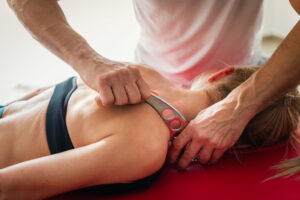1. Introduction to IASTM
Instrument Assisted Soft Tissue Mobilization (IASTM), or muscle scraping, is a modern therapeutic technique designed to alleviate muscle pain and improve mobility. By applying pressure with specialized tools to the skin and underlying tissues, it breaks down scar tissue and adhesions while enhancing blood circulation. While similar to the ancient practice of Gua Sha, IASTM has been adapted with more structured techniques and tools for therapeutic uses.
2. History of IASTM
The roots of muscle scraping date back to traditional Chinese medicine, specifically Gua Sha, which has been practiced for centuries. Gua Sha involves scraping the skin with a smooth-edged instrument to stimulate microcirculation, which is believed to improve the body’s energy flow. Modern IASTM emerged in the 1990s as practitioners started integrating these concepts with Western rehabilitation techniques. Introducing stainless steel tools designed for precision has made IASTM popular among athletes and physical therapists.
3. Types of Muscle Scraping Tools
Muscle scraping tools come in different shapes, sizes, and materials, each designed for specific applications. Here are the primary types:
- Stainless Steel Tools: These are the most common and are highly durable, making them suitable for deep tissue work. The smooth edges allow for effective scraping without causing excessive skin irritation.
- Plastic Tools: Often used by beginners, plastic tools are lightweight and less aggressive, making them ideal for individuals new to IASTM.
- Jade and Stone Tools: Inspired by traditional Gua Sha, these tools are used for gentler scraping. They are popular in wellness practices focusing on relaxation rather than intense muscle therapy.
- Curved Tools: Designed to fit specific body contours, these tools effectively target areas like the calves, forearms, and shoulders.
Each type of tool has its unique benefits, catering to different needs and comfort levels.
4. Categories of Muscle Scraping Techniques
There are various techniques for muscle scraping, each serving distinct purposes:
- Light Scraping: Involves gentle strokes to increase circulation and warm up the muscles. It is often used before intense exercise or as a preventive treatment for muscle tightness.
- Deep Tissue Scraping: This applies more pressure to reach deeper layers of muscle. This technique is commonly used to break down scar tissue and release muscle adhesions.
- Cross-Friction Scraping: This method involves scraping across the muscle fibers to alleviate specific tension points or trigger areas. It is beneficial for treating chronic muscle knots.
- Joint Scraping: Targets areas around joints to help with mobility issues. It benefits people experiencing stiffness in areas like the knees or elbows.
These categories can be combined or used separately, depending on the muscle group’s needs and the individual’s comfort.
5. Benefits of Muscle Scraping
Muscle scraping has numerous therapeutic benefits, making it popular among athletes and people experiencing muscle discomfort:
- Pain Relief: The technique effectively reduces muscle tension, alleviating chronic and acute pain.
- Enhanced Mobility: Muscle scraping helps increase the range of motion in joints and muscles by breaking down adhesions and improving blood flow.
- Accelerated Recovery: Athletes often use muscle scraping to speed up injury recovery by promoting healthy tissue regeneration.
- Improved Blood Circulation: The scraping motion stimulates blood flow, which helps deliver oxygen and nutrients to muscles and removes waste products.
- Non-Invasive Alternative: Muscle scraping offers a gentler, non-invasive approach compared to more aggressive treatments like injections or surgery.
Regular muscle scraping can significantly enhance athletic performance and general well-being.
6. Drawbacks and Risks of Muscle Scraping
While muscle scraping has many benefits, there are potential drawbacks and risks associated with the technique:
- Initial Discomfort: The scraping process may cause discomfort, mainly when pressure is applied to areas with significant tension.
- Bruising and Redness: The skin may exhibit temporary redness or bruising due to the increased blood flow and pressure applied during scraping. This can be more pronounced for individuals with sensitive skin.
- Not Suitable for Everyone: People with certain conditions, such as open wounds, skin infections, or blood clotting disorders, should avoid muscle scraping.
- Requires Skill for Effective Use: Improper technique can lead to muscle soreness or even aggravate an injury. It is advisable to learn from a professional before attempting muscle scraping independently.
To minimize these risks, beginners should start with lighter techniques and gradually progress as they become more familiar with the process.
7. Latest News and Scientific Research on Muscle Scraping
Recent studies have explored the effectiveness of muscle scraping in treating musculoskeletal pain and enhancing athletic performance:
- Study on Pain Relief: A 2023 study published in The Journal of Physical Therapy Science found that IASTM significantly reduced pain and improved functional outcomes in individuals with chronic neck pain. The research emphasized the importance of proper techniques for maximizing benefits.
- Athletic Performance: Research from The International Journal of Sports Physical Therapy indicated that incorporating muscle scraping into athletes’ recovery routines could improve flexibility and decrease delayed onset muscle soreness (DOMS) after intense exercise.
- Comparison with Gua Sha: A 2022 review in The Journal of Traditional and Complementary Medicine discussed the similarities and differences between muscle scraping and Gua Sha. It concluded that while both techniques improve blood flow and tissue mobilization, muscle scraping’s structured approach makes it more suitable for targeted therapeutic use.
Staying informed about the latest research helps practitioners refine techniques and maximize the therapeutic benefits of IASTM.
